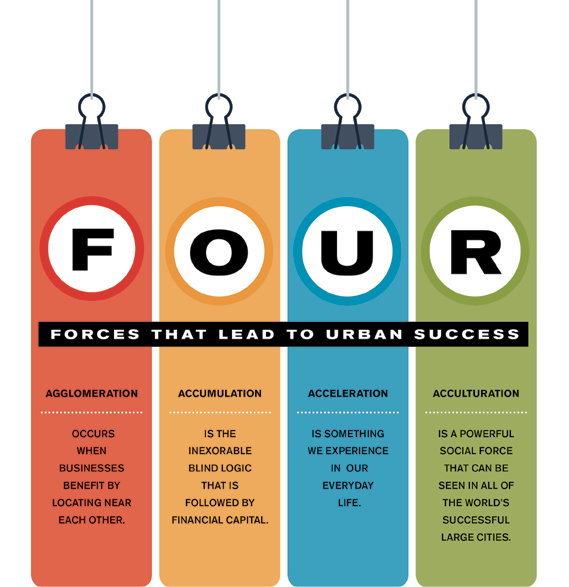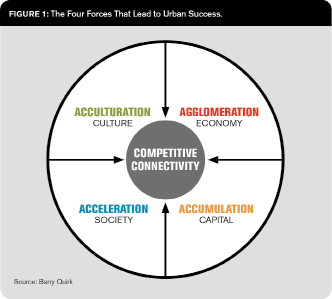
By Barry Quirk
Cities and counties may be imagined by planners or architects; their directions may be invoked by politicians or civic leaders; and their capabilities may be burnished by financiers or educators. Ultimately, however, they are successful because of the collective energies and the creative chaos of the people who live and work in them.
Localities may be composed principally of bricks but they are created by people's drive to succeed and to belong. Ambition and attachment are the two key desires that underpin a city's success. You are part of the place in which you live, and this place is a part of you.
Nation states are concerned about the overall success of their economies and the control of their borders. By contrast, communities are concerned about how their core businesses are connected to markets in other communities, nationally and internationally.
This is a real challenge in the United Kingdom at present as Britain is planning to withdraw from the European Union (EU). With 48 percent of all exports from the UK going to nations within the EU, every city is focused on the pattern of demand for the goods and services produced by its businesses. We are anxious that our primary market for exports will be more challenging in the future.
Added to this is the problem that the UK economy is heavily skewed towards the success of London, its only true global city. London has 13 percent of the UK's population, it employs 24 percent of all new graduates in the UK, and it collects 30 percent of all UK taxes.
A Balanced Pursuit of Success
This is why during the past decade since the financial crash, residents have witnessed a renaissance of urban policy in the UK. Cities across the nation have focused on how best to improve their overall performance.
The policy challenge for cities is how best to balance economic, financial, social, and cultural goals. As author and presenter Richard Florida explained at the 2017 ICMA Annual Conference in San Antonio, it is easy for cities to become unbalanced in their drive to be economically successful and pursue simplistic agendas.
Cities that pursue success by concentrating on one sector of the economy take significant risks. And those that seek success simply through external direct investment may overlook the distinctive capabilities that they possess locally.
Too often, policymakers also neglect social and cultural agendas. Managers need to balance the risks and threats to success in their cities and not just plan for growth in a hopeful and optimistic fashion, especially given that economic resilience is crucial for racial justice, social cohesion, and inclusive growth.
In an extended essay published by the UK's New Local Government Network, a group of some 50 organizations from the public and private sectors that are united by a belief in innovation and creativity (www.nlgn.org.uk), I set out the four forces that lead to urban success in the 21st century. These forces are involved in a complex interplay (see Figure 1).
Managers need to enable each of these forces to develop locally, but they may also need to tame them. That's because left alone, these forces will feed upon themselves. What starts as being a driver for success can easily end by distorting economies and become a source of urban failure.
There are many examples of urban decay arising from where local economies have become overspecialized. This is an increasing problem in the 21st century when most goods and services are designed in one place, produced in another, and are also subject to complex chains of distribution, exchange, and consumption. Cities that are overspecialized in one sector of the economy or in one set of products or services are probably taking too many risks in an uncertain global future.
Four Forces for Urban Success
Cities are where the pace of life is fastest—where social and economic innovation arises. Cities are where people of difference connect and learn from each other. Cities are where capital accumulates in the development of property and in the financing of business.
This complexity of urban life is why the most livable and sustainable cities are those that go beyond simplistic agendas to champion urban policies that blend economic, financial, social, and cultural forces. Here is a closer look at these four forces that make cities thrive:
1. Agglomeration occurs when businesses benefit by locating near each other. It is related to the concepts of economies of scale and network effects. As businesses in related fields cluster together, their costs of production may fall and they thereby experience increasing returns to scale.
Post-industrial cities rely heavily on the service sector and the high-value-adding knowledge sector. And yet, cities based almost exclusively on the service sectors reveal the same form of strong spatial clustering that is associated with manufacturing.
To facilitate emergent clustering, city governments focus on such effective infrastructure investment as rail, roads, and housing that can serve to amplify existing labor market clusters as well as generate new ones.
Even when competing with firms in the same sector, there may be advantages in businesses locating near each other because the cluster attracts more suppliers and customers than a single firm could achieve alone.
2. Accumulation is the inexorable blind logic that is followed by financial capital. It surfs on the uneven development of economies around the globe and the variable rate of return found in different asset classes and sectors of the world's economies.
The pursuit of capital accumulation—both current and anticipated—is essential to the financial lifeblood of cities. Capital accumulation is closely tied to the production and construction of the urban form as well as to the pursuit of future rental flows.
And if businesses and investors cannot make a return on their cash in one city, they will look for another. Cities cannot grow and be successful without a fresh flow of money to invest in properties and businesses.
It is not feasible for everyone, everywhere to pull themselves up by their own bootstraps; sometimes we need a boost from people who are based elsewhere, investing in us here.
3. Acceleration is something we experience in our everyday life. Things just seem to get faster, and especially so in cities. As a result, this produces what has become known as a "Red Queen effect." In Lewis Carroll's 1871 fantasy novel, the Red Queen said to Alice, "It takes all the running you can do, to keep in the same place. If you want to get somewhere else, you must run at least twice as fast as that!"
Thus, when the pace of change in the world is increasing you have to move faster and adapt more quickly if you want to keep ahead. Agility, adaptability, and innovation are the key words of those who live at the cusp of change.
This form of "evolutionary arms race" stems from the dynamic pulse of life where we try to outpace not just the rate of change in our operating environment but the rate of change at which our contemporaries are moving.
4. Acculturation is a powerful social force that can be seen in all of the world's successful large cities. It is the process of hybrid cultural change that results from contact between culturally dissimilar people, groups, and social influences. These differences can be a blend of ethnicity, nationality, faith, and identity.
The co-existence of different cultures in the same localities can result in syncretism, where two cultures merge through amalgamation; however, more hybrid adaptations usually emerge when cultures connect and collide. Acculturation is the source of fresh thinking, new ideas, and social innovation. On the streets of Manhattan, a stall selling "Halal hot dogs" offers one small symbol of the process of acculturation.
As you incorporate these concepts into your managerial mindset, consider these additional steps that can help your city thrive:
- Choose a functional urban economic area that makes sense and admit that your city is porous and is subject to enormous spillover and leakage effects from elsewhere. Don't accept the jurisdictional boundaries of your city as the reach of its economy. Start with the goal of increasing your city's competitive connectivity to other places.
- Acknowledge that you can't impose economic clusters; they occur emergently. You can foster the conditions for some clusters to be realized; these will stem from the distinctive capabilities in your city and its business communities. You simply can't decide exactly where others will be entrepreneurial and innovative. You must make plans but don't get deluded by them.
- As cities are places of people with a bewildering diversity of ethnicity, national origin, faith, identity, and values, your role is to help them build bridges with each other rather than for them to live in segmented places. Harmony, tolerance, empathy, respect, and the celebration of difference are the watchwords.
- Build a sense of belonging in your community to help cushion the impact of the fast pace of life. Successful places require scale for their specializations to work, but scale can be a problem. Commuting for hours a day, for example, corrodes a sense of livability. Local governments need to foster urban development allied to inclusive growth that fosters social cohesion, and it also helps people deal with the increasing pace of life.
Fostering the Civic and the Civil
Cities and counties don't just deal with the nation states that host them. They build compacts with the residents who live there. The communities and their residents together nurture "the civic": the virtues, the duties, and the habits that sponsor engaged citizenship.
They also foster "the civil": the sense of empathy, courtesy, and reciprocity that sponsors a sense of community and helps people connect across differing identities and cultures.
Barry Quirk, is chief executive of Kensington & Chelsea, London, United Kingdom (barry.quirk@me.com).
New, Reduced Membership Dues
A new, reduced dues rate is available for CAOs/ACAOs, along with additional discounts for those in smaller communities, has been implemented. Learn more and be sure to join or renew today!

